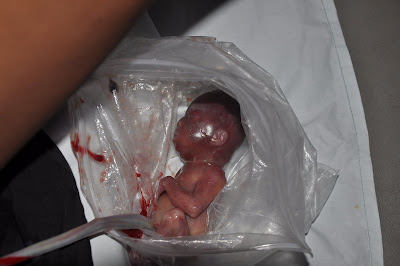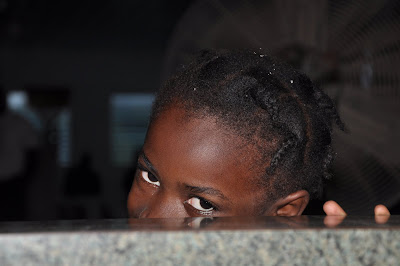
Photo by John Carroll
Cite Soleil, Haiti
July 29, 2010
SIX MONTHS AFTER THE EARTHQUAKE
Cuba has not forgotten Haiti
Leticia Martínez Hernández
SIX months have passed, but it seems like yesterday when, on that January 12, the faces of this agitated, forgetful world turned toward Haiti, the poorest nation of the American continent. Then the earth was shaking infernally and the international community lamented the tragedy that had befallen the nation of Toussaint L’Ouverture.
The people who breathed their last breath amounted to hundreds of thousands, and one million lost the roofs of their homes in which they spent their nights and sheltered from the sun and showers… Six months after the earthquake that devastated Port-au-Prince, more than one million people are still sleeping rough in tents and waking up to despair despite the promised aid from many countries. Six months after the earthquake "the dance of the millions" continues without it materializing, and the gestures of goodbye are becoming commonplace.
The Haitian capital is still an immense refugee camp, with more than 1,300 camps that have become ‘stable residencies’ for those who have lost everything, and every morning they go off to find ways of surviving in a country where options of work, apart from the informal markets, are becoming more and more elusive.
Meanwhile, the rubble remains impassable, the dumps constant fixtures, the rainy season is threatening, illnesses are lying in wait, forests are disappearing and uncertainty is overpowering a nation extremely lacerated after so many years of capitalist exploitation.
However, the world has once again turned its back on Haiti. One figure is enough to back up this hypothesis: the country has only received 2% of the close to $10 billion that the international community promised to donate for its reconstruction.
And so the prophetic words of Comandante en Jefe Fidel Castro in his Reflection of January 16 resound with a hard truth: "In Haiti, it will be put to the test how long the spirit of cooperation will endure before egotism, chauvinism, petty interests and contempt for other nations prevail."
While some are turning the page on the tragedy of Haiti, Cuba does not want to forget, it cannot do so, because more than 11 years of work there have made it understand the value of a hand extended in time, like that of the night of January 12 when the first hospital to give help to the wounded of the earthquake was that of the Cubans, or when, in 2008, merciless rain buried the city of Gonaïves in the mire and the corpses reached into the hundreds, and only the Cuban doctors weighed anchor there in order to help save lives and share the same fate as the Haitians. For this reason, it doesn’t seem strange or, even less, an exaggeration that in response to an inquiry about the doings of our doctors, many Haitians will say, totally naturally, "After God come the Cubans."
Thus, another figure is more demonstrative. When the earth shook in Haiti, 331 Cuban doctors were already there, and their numbers now stand at 1,010 between Cubans and graduates of the Latin American School of Medicine, attending to anyone at any hour of the day or night. They are striving to totally reconstruct the collapsed health system which, in a few years, will provide coverage for more than 75% of the population: a dream until yesterday prohibited for those without sufficient gourdes (national currency) to enter health institutions, even for a simple injection.
For that reason little Kevens of Haiti is eternally grateful for the prosthesis that will give him the chance to play Ronaldinho-style football again; and 70-year-old grandfather Paul Benito, whose health has always been neglected, is dumbfounded by the fact that when his high blood pressure took him to the brink of death, the Cuban doctors treated him without asking for anything in exchange.
This is how it has been since 1998, when Hurricane George devastated Haiti and our medics planted their flag for the first time in this much-lashed nation.
From that time, many are the stories recounted about that enduring love, like that of Logista, a beautiful young woman who lost both her legs in the earthquake and arrived at the hospital with a hemoglobin level of two and medical nurse José Enrique gave her a blood donation so that she could smile again.
Today this young woman is more alive than ever and the Cuban doctors are teaching her to walk again with prostheses sent from Cuba. How to forget the joy of Mackende in La Renaissance Hospital in Port-au-Prince, when Nurse Marlene Jorge, "his other mom," visited him every afternoon in the ward where he was awaiting an operation on his leg. The child had lost all of his family in the earthquake and only had the Cuban medics for company.
That simple and sensitive is our aid in Haiti, acts of help forgotten more than once by those who are constantly involved in their Herculean task, even when the total of patients treated after the earthquake is in the vicinity of 500,000; when approximately 180,000 Haitians are finding relief in 30 rehabilitation rooms; when more than 150,000 operations have been performed; when more than 125,000 people have been immunized; when prosthesis and electro-medicine workshops are materializing or when 22 community referral hospitals are functioning thanks to Cuba and the countries of the ALBA (Bolivarian Alliance for the Peoples of Our America).
And as if that was nothing, other groups of Cubans are building houses and setting up fish farms, teaching literacy, or restoring to life an abandoned sugar mill… They are the architects, engineers, teachers, veterinarians, fishers and sugar-cane workers who, alongside the medical brigade, are giving lessons in lasting aid, aid with a view to the future that will end the avalanche of "band aids" which conceal the wounds of Haiti every year.
Six months have gone by, even though it seems like yesterday. Port-au-Prince and its surrounding areas remain the seat of "the inferno of this world," in which so many people are surviving in infrahuman conditions without any idea whatsoever of how long the punishment will last.
Meanwhile, the world continues to suffer from amnesia, and the peoples, as Fidel wrote this past January 16; "will be increasingly harsher and more implacable" in their criticisms. But there are still those who believe in the future of Haiti, of that beloved Haiti captured in a famous song, of that Haiti which is discovering the smiles of its children, perhaps a joyful presage of a future that, of necessity, has to be better.

























